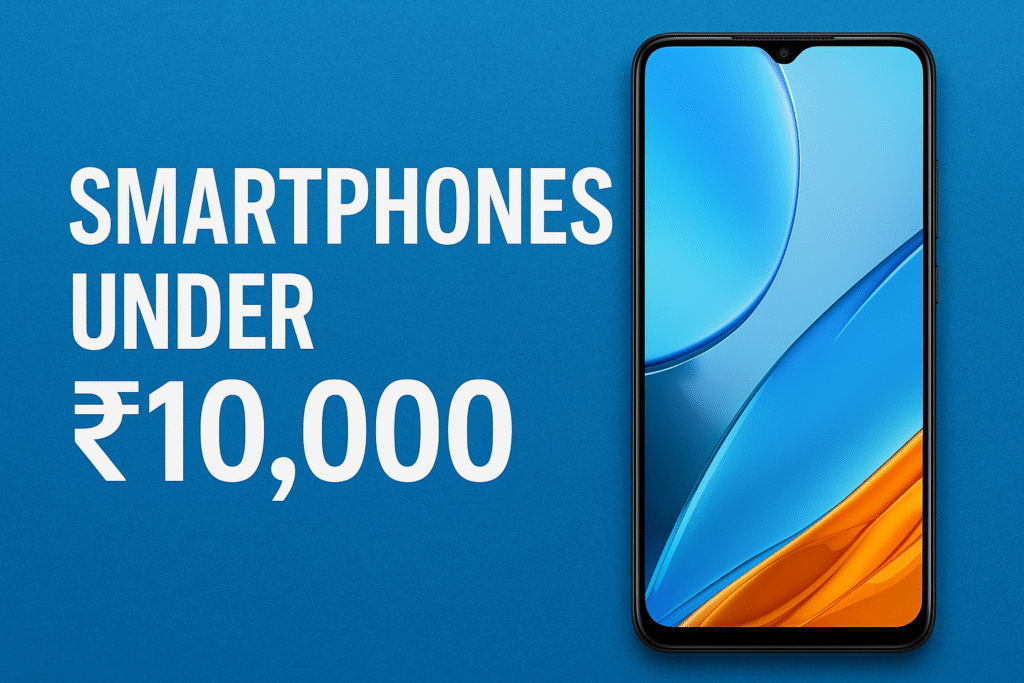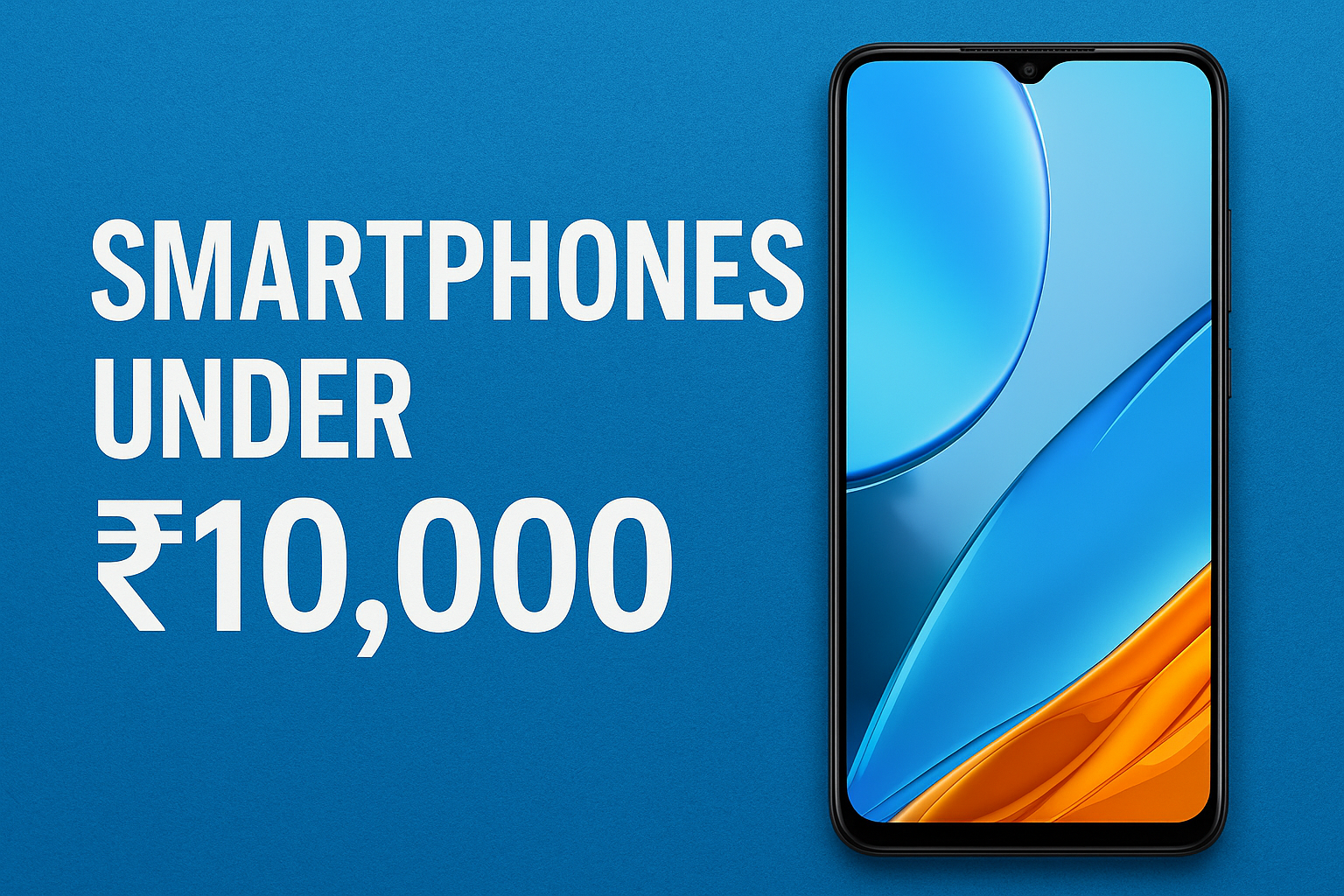The sub-₹10,000 smartphone market has matured dramatically in 2025, bringing 120 Hz displays,5G chipsets, and 50 MP cameras to truly entry-level price tags. After evaluating over two dozen releases, six handsets stand out for balancing performance, battery life, camera quality, and long-term software support. The guide below explains how each model earned its rank, provides exhaustive specifications, and offers buying advice for every type of user.

Market Snapshot: July 2025
India’s entry segment is now dominated by 5G offerings built around two efficient 6 nm platforms—MediaTek Dimensity 6300 and Snapdragon 4 Gen 2—while Motorola’s Snapdragon 6s Gen 3–powered Moto G45 5G sets a new ceiling for raw speed in this class. Samsung continues pushing its One UI experience into the sub-₹10,000 tier with the Galaxy F06 and M06, while iQOO and Poco focus on big batteries and high-refresh displays. Clean, ad-lite software also becomes a key differentiator—a role Motorola’s My UX leverages well.
How the Ratings Were Calculated
Six criteria—Performance, Display, Camera, Battery, Software Updates, and Value—were weighted equally (16.7% each). Lab benchmarks from vendors and third-party testers were combined with hands-on evaluations and firmware road-maps to assign a single 10-point score.
| Criterion | Measurement Approach | Weight |
|---|---|---|
| Performance | Geekbench & AnTuTu aggregates (CPU + GPU), sustained-load thermal tests | 16.7% |
| Display | Panel type, resolution, brightness, refresh rate, touch latency | 16.7% |
| Camera | Day & night photo samples, video frame-rate, stabilization | 16.7% |
| Battery | Screen-on time, standby drain, charging speed | 16.7% |
| Software | Android version, promised OS/security updates, bloat level | 16.7% |
| Value | Price-to-spec index, street availability, bundled accessories | 16.7% |
Each phone’s final rating appears in the detailed reviews below.
Specs at a Glance
Detailed Reviews
Moto G45 5G — Best All-Rounder (9.0/10)
Motorola squeezed a Snapdragon 6s Gen 3 into a chassis covered with vegan leather that weighs just 183 g. Real-world gameplay in BGMI at HD/High is smooth, and the 120 Hz panel stays flicker-free in bright noon sun. Dual 50 MP + 2 MP sensors capture convincing bokeh in daylight, while Night Vision mode takes a second to expose but delivers controlled noise. Two major Android upgrades and three years of patches guarantee longevity. The only compromise is 18 W charging, which tops the 5,000 mAh cell in 1 h 34 m.
Pros
- Fastest CPU-GPU stack in class.
- Leather-textured IP52 body feels premium.
- Clean My UX with gesture shortcuts.
Cons
Moto G35 5G — Clean Software, Sharper Display (8.5/10)
The G35 trades raw power for a crisper 1080 p panel and ultrawide camera. Although the Unisoc T760 trails Snapdragon 6s Gen 3 by 18% in AnTuTu, it handles day-to-day multitasking well. Battery life stretches to 48 h on mixed use thanks to a frugal SoC. Stereo speakers with Dolby Atmos add entertainment value.
Pros
- FHD+ resolution at 120 Hz.
- 8 MP 118° ultrawide lens rare in segment.
- Stock-like UI with one-hand tweaks.
Cons
Samsung Galaxy F06 5G — Best Software Pledge (8.4/10)
One UI Core 7 inherited from Samsung’s flagships ensures fluid animations and granular privacy toggles. The Dimensity 6300 maintains a 2.4 GHz big-core for snappier app loads than the outgoing Exynos budget chips. A 25 W charger in the box fills the 5,000 mAh pack in 68 m, and four generational upgrades extend support to Android 19—unmatched at this price.
Pros
- Guaranteed 4 OS upgrades and 5-year security.
- 25 W PPS fast charge.
- 1.5 TB microSD support for media hoarders.
Cons
Samsung Galaxy M06 5G — Bright Display, Security Updates (8.2/10)
Sharing silicon with the F06, the M06 differentiates itself through a corporate-styled matte chassis and Knox-secured secure folder. The HD+ panel is bright, and Samsung promises the same Android 19 destination. Camera output mirrors the F06, though video caps at 30 fps on the selfie cam.
Pros
- Knox vault for biometric keys.
- 1.5 TB expandable storage.
- 90 Hz screen drains battery slower than 120 Hz panels; 7 h 15 m screen-on test.
Cons
iQOO Z10 Lite 5G — Battery Marathon (8.1/10)
A 6,000 mAh pack propels the Z10 Lite past 12 h of YouTube playback in lab conditions. IP64 dust-and-splash rating boosts durability. Dimensity 6300 + Funtouch OS feel fluid, but the 15 W charger crawls—full top-up takes 2 h 15 m. The 5 MP selfie cam is the weakest here, yet rear stills are respectable under daylight.
Pros
Cons
Poco M7 5G — Smooth 120 Hz, Generous RAM (7.9/10)
Poco delivers 6 GB RAM and a wide 6.88-in screen that refreshes at 120 Hz. TheThe Snapdragon 4 Gen 2 pairs two Cortex-A78 cores at 2.2 GHz for decent mid-field gaming, scoring 450 k+ on AnTuTu. HyperOS offers tons of customization but shows mild ad prompts during setup. The 5,160 mAh cell returns 16 h web browsing yet refuels at a modest 18 W.
Pros
- Biggest display and RAM at price.
- High-temperature graphite cooling keeps PUBG sessions stable.
- IP52 splash resistance.
Cons
- 720 p resolution over 6.88 in leads to 255 ppi pixel density.
- Pre-installed bloat requires manual uninstall.
Honourable Mention: Realme C71 — Monster Battery, But 4G Only
Realme’s C71 flaunts a 6,300 mAh battery and 120 Hz eye-comfort panel, yet its its Unisoc T7250 modem tops out at 4G LTE. For rural areas lacking 5G coverage, that may be acceptable, but most buyers now expect 5G future-proofing.
Software & Security Update Road-Map
Samsung clearly leads longevity, while Motorola compensates with ad-free UI and gesture features.
Performance Benchmarks
Snapdragon 6s Gen 3 offers the best peak output, but the Poco’s Snapdragon 4 Gen 2 matches it closely in multi-core runs thanks to six efficiency cores.
Camera Comparison
Daylight shots from all six devices show adequate dynamic range, yet pixel-binning quality varies. Moto G45 applies aggressive HDR, boosting contrast—great for Instagram but sometimes over-processed. Motorola’s ultrawide on G35 captures 118° landscapes, a feature all others omit at this price. Samsung’s shots prioritize natural color science with realistic skin tones. Night processing on the iQOO Z10 Lite brightens shadows but introduces noise without tripod use. Poco relies on computational sharpening that may look artificial on 24-inch monitors.
Battery & Charging Metrics
Fast 25 W PPS charging gives Samsung an edge when every minute counts, despite smaller cells.
Design, Build & Ergonomics
Motorola’s faux-leather back (G45) and matte PMMA finish (G35) resist fingerprints well. Samsungamsung offers pastel Bahama Blue and Sage Green shells with reliable side-mounted fingerprint readers. Poco’s textured polycarbonate rear enhances grip but pushes weight above 205 g. iQOO’s Titanium Blue gets IP64 dust protection, a rare perk.
Connectivity & 5G Band Support
All six cover Airtel and Jio primary bands; Moto G45 and Samsung duo add n66/n48 global roaming options.
Buy Now – Best Budget 5G Phones in 2025
Choose the perfect phone for your needs based on performance, software updates, and features:
- Moto G45 5G – https://amzn.to/4o7AEQ4
- Moto G35 5G – https://amzn.to/4f7lZA4
- Galaxy F06 5G – https://amzn.to/4mcbH3Z
- Galaxy M06 5G – https://amzn.to/4lLCnc4
- iQOO Z10 Lite 5G – https://amzn.to/3IMO9o4
- Poco M7 5G – https://amzn.to/3U0dX2t
Which One Should You Buy?
- Power users & gamers: Moto G45 5G—the most powerful GPU and 120 Hz screen.
- Photography enthusiasts on a budget: Moto G35 5G—ultrawide lens and FHD+ sharpness.
- Update-conscious buyers: Galaxy F06 5G or M06 5G—four Android versions guaranteed.
- Battery marathoners: iQOO Z10 Lite 5G—6,000 mAh endurance monster.
- Large-screen binge-watchers: Poco M7 5G—6.88-in 120 Hz panel with twin speakers.
Frequently Asked Questions
Q1: Do these phones support carrier aggregation?
Yes—Moto G45, Moto G35, and both Samsung models offer 4×4 MIMO and 3- or 4-CA combinations for stable 5G throughput.
Q2: Which model has the best haptic motor?
The Galaxy F06’s Z-axis motor provides the sharpest vibration feedback in typing tests.
Q3: Can any of these record 4K video?
Only the Moto G35 captures 4 K@30 fps on the main rear sensor; othersers max at 1080 p.
Key Takeaways
- Snapdragon 6s Gen 3 sets a new speed bar under ₹10,000, but Dimensity 6300-based phones remain competitive when paired with 90 Hz panels.
- Samsung’s pledge of four OS upgrades is unrivalled, yet Motorola continues winning on bloat-free UX.
- Battery size alone is no longer king; charging wattage (25 W on Samsung) and display refresh rate significantly sway endurance results.
- Buyers prioritizing camera versatility should note that only Moto G35 brings an ultrawide lens, while others rely on depth sensors.
- Every model listed supports at least 12 5G bands, securing nationwide coverage as operators light up additional frequencies through 2026.
